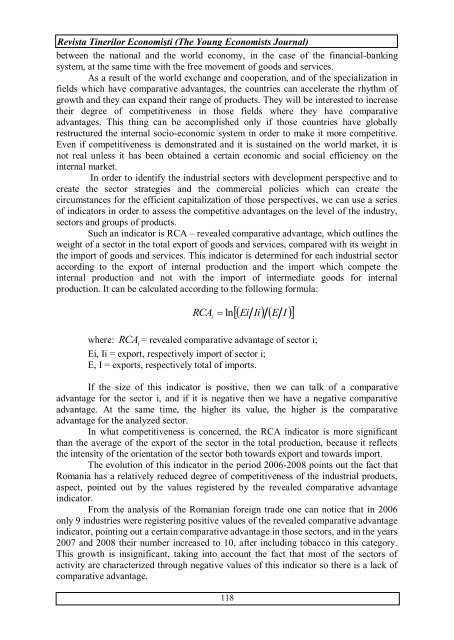Implications of change management in public administration
Implications of change management in public administration
Implications of change management in public administration
You also want an ePaper? Increase the reach of your titles
YUMPU automatically turns print PDFs into web optimized ePapers that Google loves.
Revista T<strong>in</strong>erilor Economişti (The Young Economists Journal)<br />
between the national and the world economy, <strong>in</strong> the case <strong>of</strong> the f<strong>in</strong>ancial-bank<strong>in</strong>g<br />
system, at the same time with the free movement <strong>of</strong> goods and services.<br />
As a result <strong>of</strong> the world ex<strong>change</strong> and cooperation, and <strong>of</strong> the specialization <strong>in</strong><br />
fields which have comparative advantages, the countries can accelerate the rhythm <strong>of</strong><br />
growth and they can expand their range <strong>of</strong> products. They will be <strong>in</strong>terested to <strong>in</strong>crease<br />
their degree <strong>of</strong> competitiveness <strong>in</strong> those fields where they have comparative<br />
advantages. This th<strong>in</strong>g can be accomplished only if those countries have globally<br />
restructured the <strong>in</strong>ternal socio-economic system <strong>in</strong> order to make it more competitive.<br />
Even if competitiveness is demonstrated and it is susta<strong>in</strong>ed on the world market, it is<br />
not real unless it has been obta<strong>in</strong>ed a certa<strong>in</strong> economic and social efficiency on the<br />
<strong>in</strong>ternal market.<br />
In order to identify the <strong>in</strong>dustrial sectors with development perspective and to<br />
create the sector strategies and the commercial policies which can create the<br />
circumstances for the efficient capitalization <strong>of</strong> those perspectives, we can use a series<br />
<strong>of</strong> <strong>in</strong>dicators <strong>in</strong> order to assess the competitive advantages on the level <strong>of</strong> the <strong>in</strong>dustry,<br />
sectors and groups <strong>of</strong> products.<br />
Such an <strong>in</strong>dicator is RCA – revealed comparative advantage, which outl<strong>in</strong>es the<br />
weight <strong>of</strong> a sector <strong>in</strong> the total export <strong>of</strong> goods and services, compared with its weight <strong>in</strong><br />
the import <strong>of</strong> goods and services. This <strong>in</strong>dicator is determ<strong>in</strong>ed for each <strong>in</strong>dustrial sector<br />
accord<strong>in</strong>g to the export <strong>of</strong> <strong>in</strong>ternal production and the import which compete the<br />
<strong>in</strong>ternal production and not with the import <strong>of</strong> <strong>in</strong>termediate goods for <strong>in</strong>ternal<br />
production. It can be calculated accord<strong>in</strong>g to the follow<strong>in</strong>g formula:<br />
RCA i<br />
ln<br />
118<br />
Ei<br />
Ii E<br />
I <br />
where: RCA<br />
i<br />
= revealed comparative advantage <strong>of</strong> sector i;<br />
Ei, Ii = export, respectively import <strong>of</strong> sector i;<br />
E, I = exports, respectively total <strong>of</strong> imports.<br />
If the size <strong>of</strong> this <strong>in</strong>dicator is positive, then we can talk <strong>of</strong> a comparative<br />
advantage for the sector i, and if it is negative then we have a negative comparative<br />
advantage. At the same time, the higher its value, the higher is the comparative<br />
advantage for the analyzed sector.<br />
In what competitiveness is concerned, the RCA <strong>in</strong>dicator is more significant<br />
than the average <strong>of</strong> the export <strong>of</strong> the sector <strong>in</strong> the total production, because it reflects<br />
the <strong>in</strong>tensity <strong>of</strong> the orientation <strong>of</strong> the sector both towards export and towards import.<br />
The evolution <strong>of</strong> this <strong>in</strong>dicator <strong>in</strong> the period 2006-2008 po<strong>in</strong>ts out the fact that<br />
Romania has a relatively reduced degree <strong>of</strong> competitiveness <strong>of</strong> the <strong>in</strong>dustrial products,<br />
aspect, po<strong>in</strong>ted out by the values registered by the revealed comparative advantage<br />
<strong>in</strong>dicator.<br />
From the analysis <strong>of</strong> the Romanian foreign trade one can notice that <strong>in</strong> 2006<br />
only 9 <strong>in</strong>dustries were register<strong>in</strong>g positive values <strong>of</strong> the revealed comparative advantage<br />
<strong>in</strong>dicator, po<strong>in</strong>t<strong>in</strong>g out a certa<strong>in</strong> comparative advantage <strong>in</strong> those sectors, and <strong>in</strong> the years<br />
2007 and 2008 their number <strong>in</strong>creased to 10, after <strong>in</strong>clud<strong>in</strong>g tobacco <strong>in</strong> this category.<br />
This growth is <strong>in</strong>significant, tak<strong>in</strong>g <strong>in</strong>to account the fact that most <strong>of</strong> the sectors <strong>of</strong><br />
activity are characterized through negative values <strong>of</strong> this <strong>in</strong>dicator so there is a lack <strong>of</strong><br />
comparative advantage.















